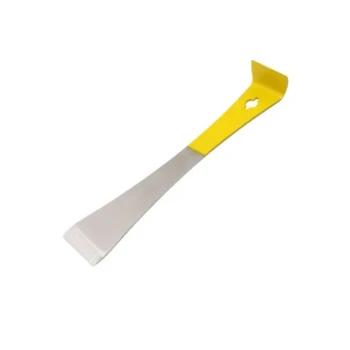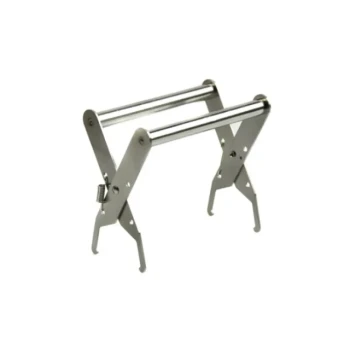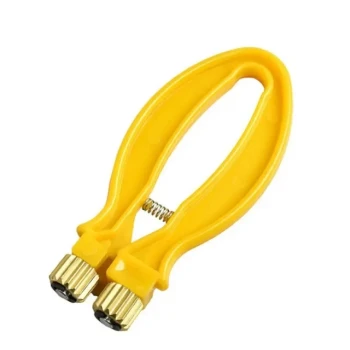At its core, beekeeping requires just a few essential tools to accomplish two primary goals: protecting yourself and effectively managing the hive. The absolute essentials are a form of protective gear like a veil, a hive tool for manipulating hive components, and a smoker to keep the bees calm. These three items form the foundation of any beekeeper's toolkit, allowing for safe and successful hive inspections.
While many comprehensive "starter kits" are available, a new beekeeper only needs a handful of items to begin. Understanding the function of the absolute essentials—protective gear, a smoker, and a hive tool—is more valuable than owning a box of tools you don't yet need.

The First Priority: Protecting Yourself
Before you can work with bees, you must ensure you can do so safely and with confidence. This is not about being fearless; it's about being prepared. Proper protective gear is what enables a calm, focused state of mind.
The Beekeeping Veil
This is the most critical piece of protective equipment. A sting anywhere else on the body is painful; a sting on the face, particularly near the eye, can be dangerous.
The veil ensures a bee-free space around your head, allowing you to observe the colony without fear of facial stings. It is non-negotiable for beekeepers of all experience levels.
The Suit or Jacket
A full beekeeping suit or a jacket-and-veil combination provides a barrier between you and the bees' stingers. This protection is what gives a beekeeper, especially a beginner, the confidence to move slowly and deliberately.
When you aren't worried about stings, you are less likely to make sudden, jerky movements that can alarm the colony. This gear is as much a psychological tool as it is a physical one.
Beekeeping Gloves
Gloves protect your hands, which are closest to the action. They allow you to handle frames coated in bees and propolis without hesitation.
The primary trade-off with gloves is dexterity. Thicker leather gloves offer more protection but can feel clumsy, while thinner goatskin or nitrile gloves provide a better feel for the hive components.
The Second Priority: Working the Hive
Once you are protected, you need tools to interact with the colony. Bees use a sticky, resinous substance called propolis to seal every crack and seam in their hive, making it impossible to open by hand.
The Hive Tool
This is your multi-purpose pry bar and scraper. The hive tool is an indispensable piece of steel used to pry apart hive bodies and frames that have been sealed shut with propolis.
It's also used for scraping away unwanted comb, cleaning frames, and removing excess wax. Without a hive tool, you simply cannot perform a hive inspection.
The Bee Smoker
The smoker is a small, canister-like device with bellows that you use to puff cool, white smoke into the hive. This is essential for maintaining a harmonious atmosphere during inspections.
The smoke masks the bees' alarm pheromone, a chemical signal they release to alert the colony to a threat. It also encourages them to gorge on honey, which makes them more docile and less inclined to fly up and sting.
The Bee Brush
While not as critical as a smoker or hive tool, a bee brush is highly recommended. It has very soft bristles used to gently sweep bees off a frame.
This is particularly useful when you are harvesting honey or need to inspect a frame without a mass of bees obscuring your view. It's a tool for gentle and precise bee management.
Understanding the Common Pitfalls
Knowing what tools to have is only half the battle. Understanding their limitations and how to use them correctly is what separates a prepared beekeeper from a frustrated one.
Over-Reliance on Gear
No beekeeping suit is 100% "sting-proof." A determined bee can sometimes find a way through a zipper, a seam, or a spot where the fabric is pulled tight against your skin.
Your gear is your primary line of defense, but your best protection is slow, deliberate movement and a calm demeanor.
Improper Smoker Use
A common beginner mistake is using too much smoke or smoke that is too hot. This will not calm the bees; it will anger them and make your inspection far more difficult.
The goal is to use just a few gentle puffs at the entrance and under the lid. The smoke should be thick, cool, and white.
The Beginner Kit Trap
Many suppliers sell large "beginner kits" full of dozens of items. While convenient, these can contain tools you won't need for months or even years.
Focus on mastering the essential tools first. You can always purchase specialized equipment like queen catchers or frame rests later, once you understand the specific problem they solve.
Making the Right Choice for Your Goal
Your initial tool selection should align with your budget and your primary motivation for starting.
- If your primary focus is keeping costs minimal: Prioritize a high-quality veil, a basic hive tool, and a reliable smoker. You can use your own loose-fitting, light-colored clothes and durable gloves to start.
- If your primary focus is maximum safety and confidence: Invest in a full, ventilated beekeeping suit. The peace of mind it provides is invaluable when you are learning the ropes.
- If your primary focus is long-term efficiency: Acquire the essentials first, but also add a bee brush and a frame rest to your initial toolkit to make your first inspections smoother and more organized.
Ultimately, your tools exist to empower you to be a calm, confident, and observant caretaker of your colony.
Summary Table:
| Essential Tool | Primary Function | Why It's Critical |
|---|---|---|
| Beekeeping Veil | Protects face and neck from stings | Non-negotiable for safety; allows calm observation |
| Hive Tool | Pries apart propolis-sealed hive components | Indispensable for performing any hive inspection |
| Bee Smoker | Puffs cool smoke to calm the colony | Masks alarm pheromones, encouraging docile behavior |
| Bee Brush (Recommended) | Gently sweeps bees off frames | Enables precise frame inspection and honey harvesting |
Ready to equip your apiary with reliable, professional-grade tools?
HONESTBEE supplies commercial apiaries and beekeeping equipment distributors with the durable, essential gear needed for efficient and safe hive management. We understand the demands of large-scale operations and provide wholesale-focused solutions to meet them.
Contact our team today to discuss your equipment needs and wholesale pricing.
Visual Guide

Related Products
- HONESTBEE Classic Pry Bar Hive Tool with High Visibility Finish for Beekeeping
- HONESTBEE Advanced Ergonomic Stainless Steel Hive Tool for Beekeeping
- Multi-Function Hive Tool with Integrated Hammer for Beekeeping
- HONESTBEE Professional Long Handled Hive Tool with Precision Cutting Blade
- Professional Dual-End Stainless Steel Hive Tool for Beekeeping
People Also Ask
- What are the alternatives to a hive tool? The Essential Tool for Every Beekeeper
- How often should the area under beehives be inspected and cleaned during the warm season? A Proactive Maintenance Guide
- What factors should be considered when choosing a hive tool? Select the Right Tool for Your Apiary
- How should frames be reassembled within the box to avoid squashing bees? Master a Gentle, Bee-Safe Technique
- What is the hive tool used for? The Essential Multi-Tool for Every Beekeeper



















